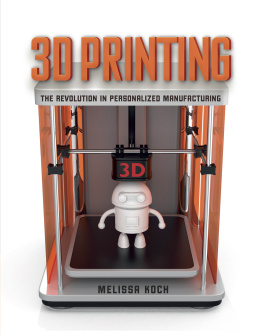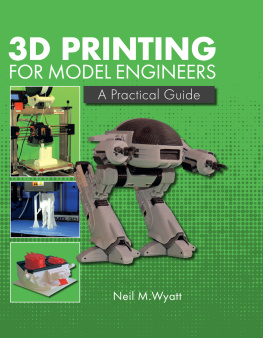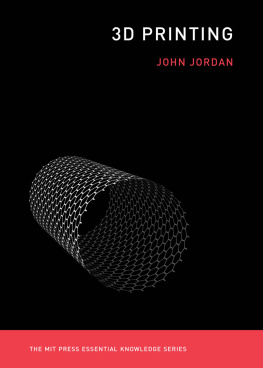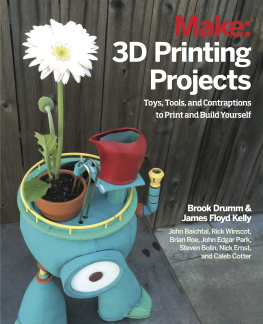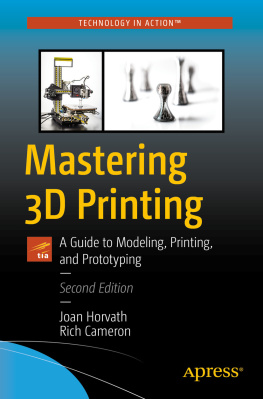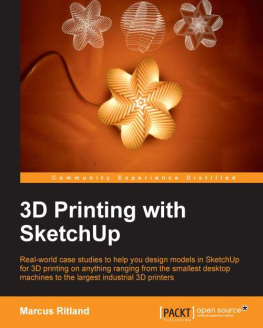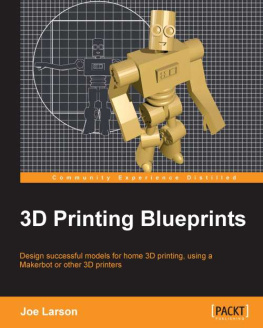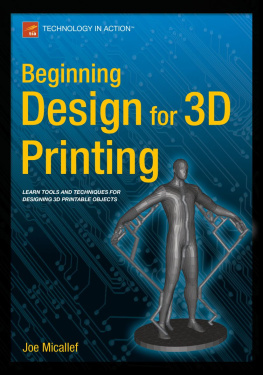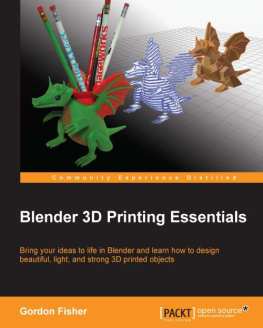He has also volunteered at a local makerspace, teaching SketchUp classes and leading 3D-printing meetups. He is currently on a quest to eliminate design-for-3D-printing illiteracy. When he's not push-pulling a model into shape, he can be found shooting photos and enjoying nature.
About the Reviewers
Bradley Rubin began using 3D printing while getting his Bachelor of Architecture degree from the Syracuse University. With a passion for storytelling and design, he has worked in both the digital and physical world of film entertainment. Brad's credits include working on films such as This is 40, The Internship, The Muppets, Real Steel, and The Hunger Games. He has worked on multiple films in the capacities of graphic consultant and as an illustrator/3D modeler. Brad spent three years in Boston working as an architect, and did volunteer work that promoted design and architecture to children and Boston area citizens.
Chris Thompson began his career in 3D printing at Hive76 hackerpsace, where he printed his first ever object: a dovetail joint, modeled in SketchUp and printed on a Cupcake CNC. He furthered his skills by building a RepRap and running 3D printer building workshops for new users.
Prior to this, he was a Technical Supervisor at NextFab Studio in Philadelphia and an expert in the field of digital manufacturing. He is also a mildly successful entrepreneur with meatcards.com. His previous positions gave him experience with laser engravers, fine hand skills, and digital design tools.
I'd like to thank Valeria, without whom nothing is possible.
Samson Tiew is a co-founder of The make lab, an online digital fabrication platform servicing the Australian market. Coming from an architecture background, he identified a gap in the market to make digital fabrication more accessible to retail customers. Within the field of design and fabrication, he is highly interested in the idea of experimental practices fused with practical experiments.
The make lab is a platform for designers and enthusiasts to fabricate and manufacture customized products. Albeit focusing on laser cutting in the interim, the personnel that form The make lab are very much in tune with other digital fabrication techniques such as CNC routing and 3D printing.
www.PacktPub.com
Support files, eBooks, discount offers and more
You might want to visit www.PacktPub.com for support files and downloads related to your book.
Did you know that Packt offers eBook versions of every book published, with PDF and ePub files available? You can upgrade to the eBook version at > for more details.
At www.PacktPub.com, you can also read a collection of free technical articles, sign up for a range of free newsletters and receive exclusive discounts and offers on Packt books and eBooks.
http://PacktLib.PacktPub.com
Do you need instant solutions to your IT questions? PacktLib is Packt's online digital book library. Here, you can access, read and search across Packt's entire library of books.
Why Subscribe?
- Fully searchable across every book published by Packt
- Copy and paste, print and bookmark content
- On demand and accessible via web browser
Free Access for Packt account holders
If you have an account with Packt at www.PacktPub.com, you can use this to access PacktLib today and view nine entirely free books. Simply use your login credentials for immediate access.
Preface
My journey into the fascinating world of 3D printing began in 2010 when I entered a 3D-printing design contest. While I didn't win the contest, I discovered a world of democratized manufacturing, where anyone could create nearly any design with a technology that was once available only to large corporations.
The new idea that 3D printers could create end-use products instead of just prototypes spawned several print-on-demand businesses that drove demand for 3D printed products and drastically reduced prices. Another important factor in the spread of 3D-printing was the expiration of patents that allowed for the development of cheap 3D printers.
Along my journey, I discovered that 3D modeling skills are difficult for many people to master, but masters of the craft are well rewarded. I also found it nearly impossible to get technical help in making printable SketchUp models, and ended up figuring out problems on my own. As I learned, I helped others in online communities use SketchUp to design their models for printing, and as a result my skills improved further.
In these early years of 3D printing for the masses, I see a real need for quality training that allows anybody to use the printers to their full potential. 3D modeling skills are not common even among the early 3D printer adopters, who are often stuck with printing what others make available online.


